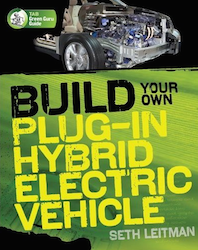This week I went techie and read “Build Your Own Plug-In Hybrid Electric Vehicle,” by Seth Leitman. I chose this book because I drive an EV – the Ford C-Max, and when I purchased my vehicle, I opted against the plug-in component because I didn’t have a place to charge my car (I live in an apartment complex). In the back of my mind I always wondered if I shouldn’t have planned for the future and purchased the PHEV version. Well now, I’ve discovered with Leitman’s help, it didn’t matter – I can covert my EV to PHEV.
 Leitman is a quite an expert. He writes for several publications including Mother Earth News and Huffington Post and is a consulting editor for the McGraw-Hill Green Guru Guides. He also runs the blog Green Living Guy.
Leitman is a quite an expert. He writes for several publications including Mother Earth News and Huffington Post and is a consulting editor for the McGraw-Hill Green Guru Guides. He also runs the blog Green Living Guy.
For those that may be new to the terminology, an electric vehicle consists of a battery that provides energy, an electric motor that drives the wheels and a controller that regulates energy flow to the motor. The only difference between an EV and a PHEV is that the EV battery is recharged through regenerative energy (apply the brakes) while the battery in a PHEV can also be recharged by plugging it in to an outlet.
So the goal of the book is both to educate people on converting their gasoline cars to PHEVs – this is where the real fuel efficiency gains come – as well as to show people that the country can move to PHEVs quickly.
One area that Leitman explains well is how much it costs, or doesn’t cost to drive an PHEV. When using the average U.S. electricity rate of 9 cents per kilowatt (using 2009 numbers) 30 miles of electric driving will cost 81 cents. Assuming that the average fuel economy in the United States is 25 miles per gallon, at $3.00 per gallon, this equates to 75 cents a gallon for the equivalent electricity. Other factors he accounts for: the environmental cost of electricity production.
I don’t have any mechanical skills, but this book is so well-written and easy to use I could actually figure out how to convert my hybrid (or a friend’s car). Granted, I would probably need some professional help but it is amazing how relatively simple and inexpensive this is especially when you factor in higher gas prices and more renewable energy being produced by utilities. My only suggestion is to update the book based on 2014 technologies because with the billions of gas cars on the road, this book will be valuable for years to come. You can purchase the book here.

